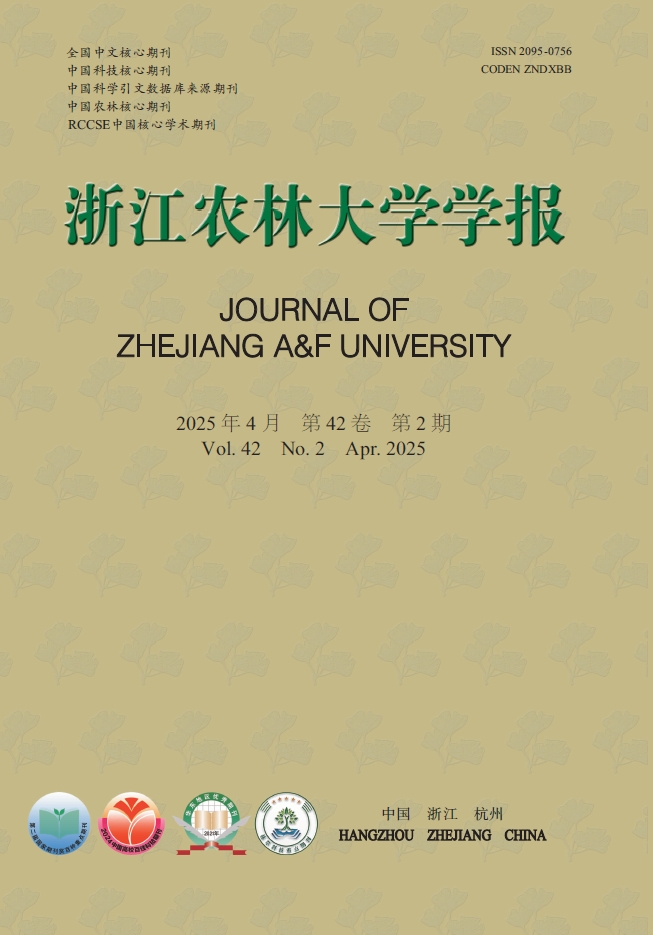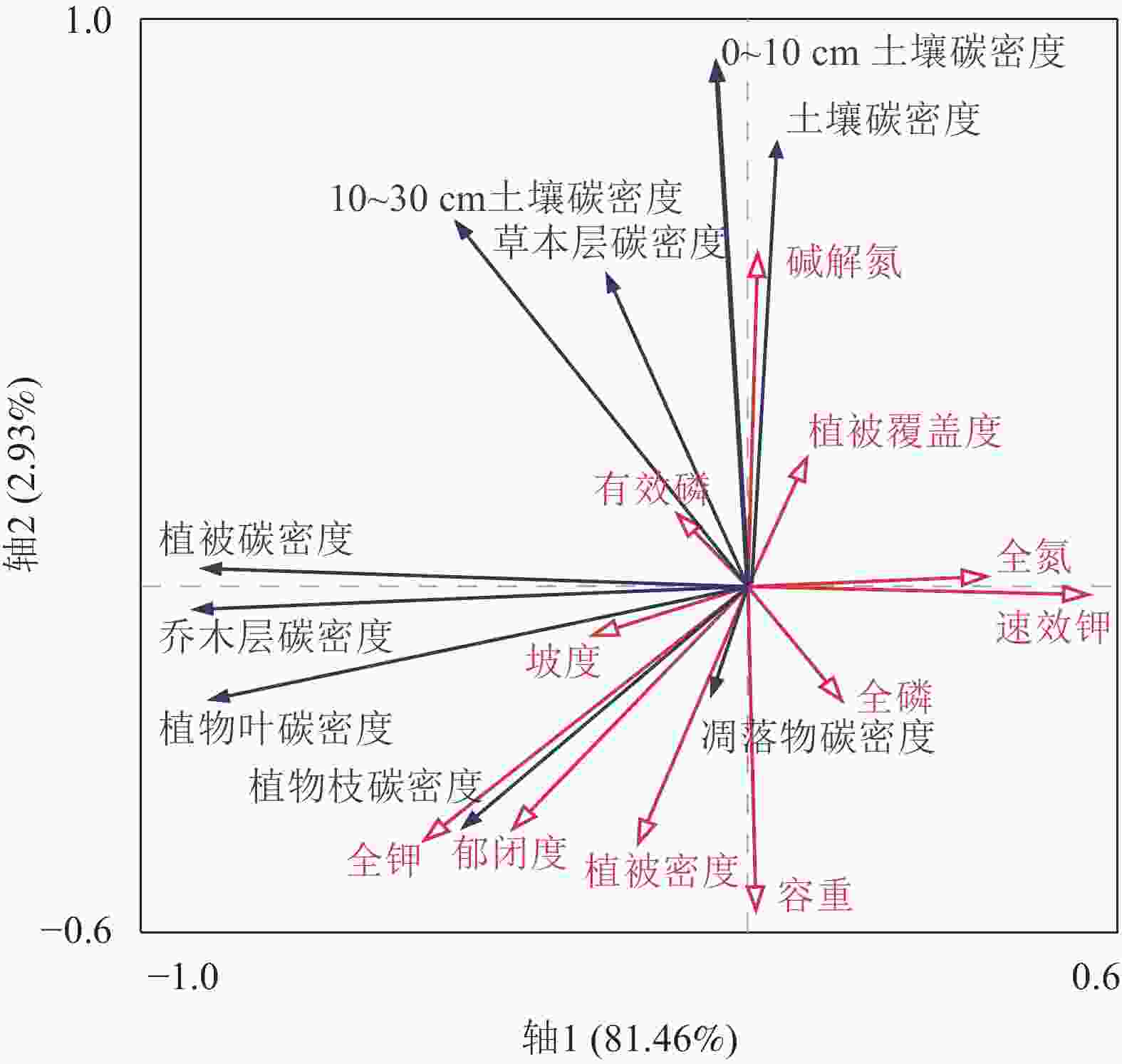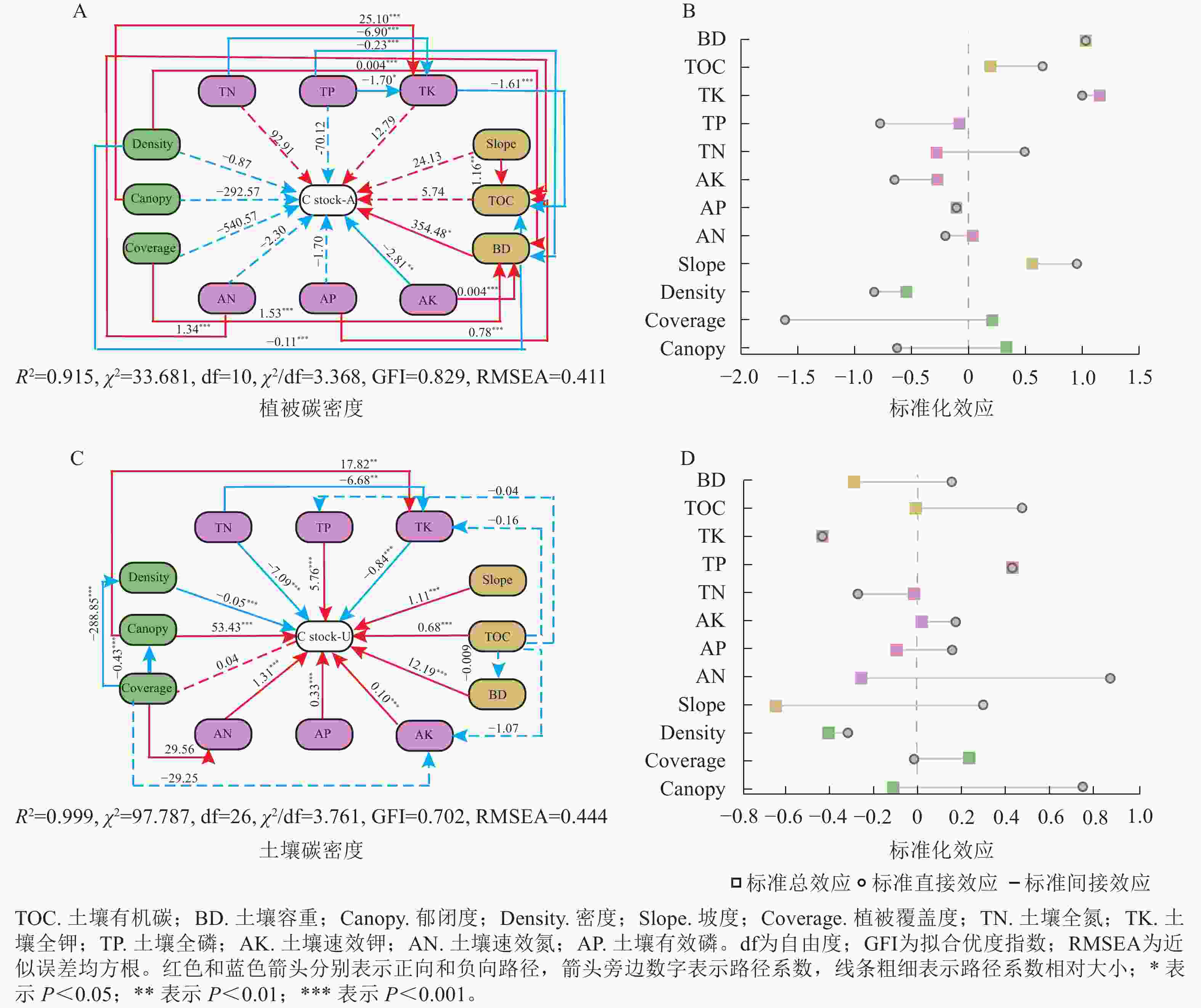-
第9次全国森林资源清查数据显示:全国森林覆盖率为22.96%,森林面积达到2.2亿hm2,森林蓄积量超过175.6亿m3[1]。大部分森林碳以活生物量和土壤有机质形式存在,约占生态系统碳密度的89%[2],因此,森林及其土壤碳库在调节全球碳平衡的过程中起着至关重要的作用。基于此,研究森林生物量和碳密度的分配特征及其主要影响因素成为了国内外学者关注的热点问题[3]。
造林年限是决定森林碳密度的重要因素[4]。随着造林年限的增加,森林植被组成和群落结构随之产生变化,进而通过改变林分密度、凋落物量、土壤养分等来影响森林碳库[5]。有研究表明:生物量碳密度随造林年限显著增加,但土壤有机碳(SOC)密度随造林年限的变化存在争议[6−8]。此外,造林年限与林分碳密度之间存在显著正相关性,在森林(包括乔木层、灌木层、草本层和土壤)碳分配中发挥着重要作用[9−11]。土壤有机碳库是陆地生态系统最大的碳库,其碳储量超过了大气和植被中碳储量的总和,对于维持碳平衡[12]至关重要。同时,土壤有机碳是土壤质量、土壤肥力、土壤持水能力和土壤生产力评价[13−14]的重要指标,可直接影响森林的生物量及其固碳潜力[9−11]。相反陆地生态系统的组成、结构和功能也会影响土壤碳库[15],其中造林年限通过改变林分结构,进一步影响土壤养分分配格局。土壤碳库的微小变化都会影响土壤性质、全球碳循环和气候变化[16−17],因此准确估算区域碳分配和碳密度有利于更好地理解森林碳库。
人工林在减缓温室效应和应对气候变化中发挥着重要作用[18]。在中国,马尾松Pinus massoniana因生长迅速且适应性强,常常作为先锋树种被广泛用于植树造林[19]。多时段、分批量地种植马尾松会产生不同龄级的人工林,对后续有效管理马尾松林造成阻碍,但同时也为研究不同造林年限马尾松林碳密度变化规律提供条件。量化马尾松人工林碳密度的变异性和分配模式可以更好地预测未来森林固碳能力[20]。目前还缺乏关于马尾松人工林在不同造林年限下土壤、凋落物和植被碳密度的差异研究。本研究选取造林年限为8、12、22、38 a的马尾松林地为研究对象,系统研究影响土壤和植被之间不同碳分配特征的因素,以期为马尾松人工林系统优化和森林碳汇潜力提供科学依据。
-
研究区位于浙江省杭州市淳安县千岛湖镇姥山林场(29°33′30″N,119°02′55″E)。该研究区属于亚热带季风气候区,总体呈现夏季高温多雨,冬季寒冷少雨的特征。年平均气温为17.1 ℃,≥10 ℃的年积温为5 410.0 ℃,年平均日照时数为1 951.0 h,年降水量为1 430.0 mm。平均海拔为150 m,坡度为20°~30°。土壤类型为黄红壤亚类。本研究选择姥山林场中,造林年限分别为8、12、22、38 a的马尾松林。这些样地最初种植密度相同,后续差异来源于马尾松在生长过程中的自然生长和死亡。样地基本概况见表1。
样地代号 造林年限/a 海拔/m 坡度/(°) 坡向 平均胸径/cm 平均树高/m 密度/(株·hm−2) 2016-1 8 146 10.4 西北 13.3 12.6 1 800 2016-2 8 145 0.5 北坡 14.8 13.5 1 600 2016-3 8 141 16.5 北坡 14.3 13.6 1 700 2012-1 12 139 4.3 东南 14.5 14.8 2 400 2012-2 12 158 2.6 东南 12.0 15.6 2 500 2012-3 12 148 14.7 东南 13.5 9.8 2 200 2002-1 22 148 6.6 西南 19.2 30.9 2 300 2002-2 22 141 11.3 西北 25.2 23.9 2 000 2002-3 22 129 0.5 西北 29.9 25.4 1 900 1986-1 38 139 7.1 东南 33.9 29.0 1 800 1986-2 38 144 6.8 西北 26.5 28.6 1 900 1986-3 38 150 6.1 东北 26.1 23.8 1 800 Table 1. General situation of the sampling plots
-
采用“空间替代时间”的方法[21],选取该区域地形条件相似的4个马尾松人工林造林年限组:幼龄林(8 a)、中龄林(12 a)、近熟林(22 a)、成熟林(38 a)。每个造林年限设3个重复样地,大小为400 m2 (20 m×20 m),共计12个样地。对胸径≥3 cm的马尾松胸径、树高、冠幅等进行每木调查,统计样地内的马尾松株数用于计算植被密度。草本调查样方为2.5 m×2.5 m,记录样方的出现物种的物种名、高度、盖度等数据。选择各样地中胸径与平均胸径相同的马尾松作为标准木,采集标准木上、中、下部位的叶、枝等器官,混合后取500 g带回实验室分析。在样地中挖取土壤剖面,采集0~10和10~30 cm的土样,剔除其中的石块后取500 g带回实验室分析,并用环刀法测定容重。样地理化性质如表2。
造林年限/a 容重/(g·cm−3) 含水率/% pH 碱解氮/(mg·kg−1) 有效磷/(mg·kg−1) 速效钾/(mg·kg−1) 8 1.07±0.16 bc 31.71±7.94 ab 4.96±0.08 b 74.42±25.67 a 53.00±5.07 a 72.17±28.56 ab 12 1.23±0.12 ab 28.67±1.02 c 5.11±0.09 a 65.75±13.28 a 49.53±6.23 a 92.83±21.93 a 22 1.25±0.10 a 30.00±3.76 ab 4.79±0.08 c 63.33±14.42 a 50.48±2.31 a 54.50±8.80 b 38 1.05±0.07 c 36.71±5.50 a 4.93±0.13 b 75.25±9.84 a 51.54±4.83 a 73.50±12.60 ab 说明:数据为平均值±标准差。根据GB/T 26424—2010 《森林资源规划设计调查技术规程》划分造林年限,马尾松1~10 a为幼龄林,11~20 a为中龄林,21~30 a为近熟林,31~50 a为成熟林,≥51 a为过熟林。不同小写字母表示相同理化性质不同造林年限间差异显著(P<0.05)。 Table 2. Basic physical and chemical properties of soil at different afforestation ages of P. massoniana
-
采回的植物样品用去离子水洗净后,在烘箱内105 ℃杀青30 min,随后在烘箱内80 ℃烘干至恒量。将烘干后的马尾松样品粉碎,过100目筛后装入塑封袋备用。植物碳质量分数用重铬酸钾-外加热硫酸氧化法进行测定;植物氮、磷、钾采用H2SO4-H2O2消煮法提取,提取液用于进一步测定。氮质量分数用半微量凯氏定氮法测定;磷质量分数用钼锑抗比色法测定,钾质量分数用火焰光度计法测定。
采回的土壤样品置于常温下风干,风干后进一步磨碎,分别过10和100目筛后,用于pH、容重、碱解氮、速效磷、速效钾、全氮、全钾、全磷、有机质等土壤常规性质测定。土壤有机质用重铬酸钾-外加热硫酸氧化法测定;土壤pH用电位法测定,水土质量比为2.5∶1.0;土壤全氮、全磷、全钾采用H2SO4-H2O2、HClO4-H2SO4消煮提取并进一步测定。
-
采用收获法和建立各器官生物量模型的方法估测生物量[22]。根据马尾松胸径、树高实测结果,选择适合的马尾松生物量方程进行估算[23]。模型最终取值如表3所示。
组分 模型形式 a b r2 枝 W1=a(D2H)b 0.012 7 0.788 6 0.984 8 叶 W2= a(D2H)b 0.028 3 0.601 2 0.919 2 整树 W3= a(D2H)b 0.105 6 0.824 7 0.998 8 说明:W1、W2、W3分别为马尾松树枝、树叶、整株生物量(kg);D为马尾松胸径(cm);H为马尾松树高(m);a、b均为估测模型的参数。 Table 3. Estimation equation of P. massoniana biomass
草本层模型与马尾松模型不同,模型如下:
式(1)中:Wh为单位面积总生物量(kg·m−2);H为草本层平均高(cm);G为草本层盖度。
-
植被层各组分(包括乔木、草本和凋落物)碳密度由各自碳质量分数与干生物量质量之积计算所得[24]。土壤碳密度根据式(2)计算[25]:
式(2)中:Si为土壤某一层次内单位面积的土壤碳密度(t·hm−2); DSBi为第i层土壤的容重(g·cm−3);Ci为第i层土壤的含碳率(%);Hi为第i层土壤的土层厚度(cm)。马尾松林碳密度根据植被层各组分与土壤各层碳密度之和计算。
-
采用冗余分析(RDA)探究马尾松林碳密度与各类影响因子之间的相关关系,用结构方程模型(SEM)进一步判断各因子之间的关系强度,解释自变量对因变量的直接效应、间接效应和总效应。
-
使用Excel 2016和SPSS 21进行数据整理和统计分析;用Duncan新复极差法检验不同造林年限之间的差异显著性,显著性水平设定为0.05;用Pearson相关分析法对马尾松林的碳密度、生物量、基础理化性质进行相关分析;利用Origin 2021软件绘图,利用Canoco 5绘制冗余分析图。
-
随着造林年限的增加,胸径(图1A)和树高(图1B)整体呈增加趋势,并在达到成熟阶段之后趋于稳定。造林年限与胸径和树高的决定系数(R2)分别为0.819和0.896。总体来看,造林年限作为影响马尾松林生长状况的主要因素,对提升马尾松林碳密度也至关重要。
-
不同造林年限的马尾松林乔木层生物量呈现显著差异(P<0.05),乔木层生物量随着造林年限的增大而增大,在38 a (成熟林)时达到最大值,为352.02 t·hm−2 (表4)。枝和叶的生物量呈现先增加后减少的趋势,在造林年限为38 a (成熟林)时达到最大值,分别为64.57和49.79 t·hm−2。总生物量在22 a (近熟林)时达到最大值,显著大于中幼林的生物量(P<0.05),说明马尾松近熟林的生长状况最好。草本层和凋落物层生物量在造林年限为22 a时达到最大值,分别为13.74和5.24 t·hm−2。总体来看,乔木层生物量显著大于草本层、凋落物层的生物量。此外,不同组分和不同造林年限间的生物量差异揭示马尾松在近熟林时生长状态最好,具有较强的固碳能力。
造林年限/a 乔木层生物量/(t·hm−2) 草本层生物量/(t·hm−2) 凋落物层生物量/(t·hm−2) 总生物量/(t·hm−2) 枝 叶 整树 8 5.48±0.90 Cc 3.10±0.22 Cc 38.18±13.32 Bb 9.09±1.62 Cc 2.97±1.96 Cab 50.24±14.10 Ab 12 12.61±5.56 Cb 8.35±4.07 Cc 93.06±27.71 Bb 11.50±0.19 Cb 2.45±0.33 Cb 108.00±26.51 Ab 22 64.57±5.54 Ca 49.79±1.70 Ca 310.87±17.88 Ba 13.74±0.36 Da 5.24±2.11 Da 329.84±18.78 Aa 38 6.57±0.79 Bbc 35.55±8.04 Bb 352.02±100.13 Aa 12.74±1.12 Bab 3.74±0.90 Bab 368.51±99.85 Aa 说明:数据为平均值±标准差。不同小写字母表示相同组分不同造林年限间生物量差异显著(P<0.05);不同大写字母表示相同造林年限不同组分间生物量差异显著(P<0.05)。 Table 4. Biomass of each component of P. massoniana forests at different afforestation ages
-
由图2可知:乔木层碳密度随造林年限增加而增加,在38 a (成熟林)时达到最大值176.36 t·hm−2,近熟林碳密度显著高于幼龄林和中龄林碳密度(P<0.05)。草本层的碳密度在38 a (成熟林)时达到最大值,为30.10 t·hm−2,显著大于其他造林年限草本层的碳密度(P<0.05)。0~10 cm土层中,不同造林年限马尾松林的土壤碳密度存在显著差异(P<0.05),总体呈现为38 a (成熟林)时达到最大值,为38.60 t·hm−2。10~30 cm土层中,碳密度在38 a (成熟林)时达到最大值,为57.13 t·hm−2。总体上植被和土壤碳密度均在成熟林时达到最大值。这说明随着造林年限的增加,虽然马尾松的生长速度减慢,但是马尾松林的碳密度仍在积累。
-
表5显示:马尾松林植被和土壤的碳密度随造林年限的增加存在一定的起伏。随着造林年限的增加,植被和土壤碳密度总体呈现增加的趋势,在38 a (成熟林)中达到最大值。此外植被和土壤碳密度的比值逐渐增大,在22 a造林年限时达到最大值,在马尾松林到达成熟阶段之后,其植被和土壤碳密度达到稳定。由此说明马尾松成熟林阶段,其固碳能力最强。
造林年
限/a马尾松林碳密度/(t·hm−2) 碳密度占比/% 植被 土壤 植被 土壤 8 36.37±17.54 b 87.11±18.27 ab 20.12 79.88 12 57.23±11.89 b 47.84±5.72 d 50.28 49.72 22 167.67±12.87 a 72.98±8.16 bc 68.44 31.56 38 207.15±53.56 a 95.72±11.43 a 65.29 34.71 说明:数据为平均值±标准差。不同小写字母表示同一指标不同造林年限间差异显著(P<0.05)。 Table 5. Carbon storage and its ratio of P. massoniana forests
-
由冗余分析(图3)可知:轴1和轴2分别解释了总方差的81.46%和2.93%,总解释度为84.39%。土壤有效氮、土壤有效磷、土壤全氮与土壤碳密度呈正相关;土壤容重、坡度、植被密度、土壤全钾、植被覆盖度等与土壤碳密度呈负相关。分析数据显示:土壤全钾、土壤速效钾、坡向为主要贡献因子,分别解释了土壤碳密度的28.70%、27.00%、9.90%。0~10 cm土壤碳密度与土壤容重、植被密度和郁闭度呈显著负相关(P<0.05);0~10 cm土壤碳密度和10~30 cm土壤碳密度与土壤有机碳呈极显著正相关(P<0.001)。植被碳密度总体上与土壤总氮、土壤总磷和土壤速效钾呈负相关;土壤碳密度与植被覆盖度、土壤速效氮成正相关,与土壤全磷、土壤容重、植被密度等呈负相关。从以上分析可知:马尾松林环境因子和土壤氮、土壤钾质量分数对土壤和植被碳密度具有重要影响。
-
马尾松植被碳密度模型的适配度检验结果显示(图4A):R2为0.915,χ2为33.681,自由度(df)为10,拟合优度指数(GFI)为0.829,近似误差均方根(RMSEA)为0.411,表明本研究模型和数据的适配度较高,拟合情况理想,可以满足研究和分析的要求。马尾松植被碳密度与影响因素的结构方程模型路径图如图4A所示。马尾松植被碳密度影响因素中土壤容重和土壤速效钾对碳密度有极显著的影响,其中土壤容重对植被碳密度有显著正影响(P<0.05);土壤速效钾对植被碳密度有极显著负影响(P<0.05)。由图4B可知:容重和全钾的标准化总效应高于其他因子,标准化总效应对植被碳密度的影响大于直接效应。马尾松林土壤碳密度模型的适配度检验结果显示(图4C):R2为0.999,χ2为97.787,df为26,GFI为0.702,RMSEA为0.444,表明本研究中模型和数据的适配度较高、拟合情况理想,可以满足研究和分析的要求。土壤碳密度与影响因素的结构方程模型路径图如图4C所示。植被覆盖率对土壤碳密度均有极显著的正向影响(P<0.05),冠幅、土壤全磷、土壤有机碳、容重等对土壤碳密度有极显著正影响(P<0.01),植被密度、土壤全氮、土壤全钾对土壤碳密度有极显著负影响(P<0.001)。由图4D可知:土壤碱解氮和郁闭度对土壤碳密度的直接效应高于其他因子,标准直接效应对土壤碳密度的影响大于标准总效应。该模型进一步表明,土壤有机碳以及速效养分对土壤碳密度的直接影响大于植被碳密度,植被碳密度的标准间接效应高于直接效应。
-
生物量是马尾松林生长的重要属性,受胸径、树高、树种组成等林分特征,坡度、海拔等环境因素以及造林年限等人为因素的影响[26]。已有研究表明,系统掌握树木胸径、树高的生长过程,是评价马尾松林生长状况最直接有效的方法[27]。本研究发现:随着造林年限的增加,马尾松的胸径和树高呈现增长趋势,且生物量在成熟林阶段最高。这与谢伊等[28]的研究结果相同,不同造林年限下林木的生长具有显著差异,造林年限越长,径级越大,生长量越大。究其原因可能是林木的生长多取决于自身个体的大小,随着造林年限的增加,林木个体逐渐增大,导致胸径和树高随之增加,进而提升马尾松生物量。这说明造林年限作为影响马尾松生长状况的关键因素,对提升马尾松林碳密度至关重要。
-
本研究结果表明:马尾松林碳密度随造林年限增长而显著增加,马尾松林碳密度从大到小依次为成熟林(302.88 t·hm−2)、近熟林(240.66 t·hm−2)、幼龄林(123.49 t·hm−2)、中龄林(105.08 t·hm−2)。中龄林的碳密度比幼龄林小的可能原因有多个:一方面幼龄林生长迅速,新陈代谢旺盛,对养分的需求量大,通过吸收土壤养分来增加其生物量,进而提高植被部分的碳密度[29];另一方面,幼龄林林冠稀疏,光照充足,光合作用效率较高,且生长竞争较小,有利于植被层碳密度的积累[30]。成熟林阶段碳密度最高主要是因为在森林演替过程中,乔木生物量持续增加,最终导致植被碳密度大幅提升,这与郭丽玲等[31]的研究结果一致。
本研究中,马尾松幼龄林的植被碳密度和土壤碳密度分别占马尾松林碳密度的29.45%和70.55%,随造林年限增长植被碳密度的占比逐渐增加,说明植被碳密度对马尾松林碳密度的影响逐渐增加。这与前人研究结果相似,随着造林年限的增加植被碳密度也呈现增加趋势,出现植被碳密度占比更大的可能原因为:植被大量吸收有机质矿化产生的养分导致土壤碳密度降低[32]。此外本研究结果表明:乔木层碳密度在所有地上部分碳库中所占比例最高,其次是草本层,凋落物层碳密度最低。这与前人的研究结果不同,HE等[33]认为:植被生长过程中不断产生的凋落物成为地表重要的碳库,凋落物层的碳密度比草本层的碳密度更大[34]。产生不同的结果可能是由多个因素共同作用导致的:目前对凋落物的组成成分研究较多的是凋落叶,很少有关枝、球果、树皮等的研究[35−37],这可能会导致结果差异;此外气象条件(大风、雪)、林分密度、造林年限等都是影响凋落物碳密度的因素[38]。本研究所处季节并非枝叶脱落季节,且林分密度适度,故出现凋落物碳密度较小的结果。
本研究发现土壤碳密度主要集中于0~10 cm的表层中,且随着造林年限增加土壤碳密度逐渐增加,并在成熟林阶段达到最大值。这与大部分研究结果相似,植物群落会通过各种形式,如凋落物分解,促进土壤碳的积累[39]。随造林年限的增加,凋落物的分解作用和植物呼吸作用等相应增强,植被覆盖度等环境因子随之改变,导致土壤碳密度逐渐增加[40]。
-
探讨植被和土壤碳密度的主要影响因素,有助于确定影响马尾松林固碳的主控因子,进一步提高马尾松林固碳能力。本研究发现土壤容重和土壤速效钾对地上植被碳密度有直接影响;所选择的环境因子对土壤碳密度均有显著影响,其中植被覆盖率有最显著的直接正向影响。这与已有的研究结果相似:土壤理化因子(氮、钾等元素)可以通过影响土壤结构和植被生长进而影响林木碳密度[41]。出现该结果的主要原因可能是土壤养分状况好的条件下,凋落物分解快,而土壤养分状况作为森林碳密度的主要影响因素,进一步促进马尾松林碳积累[42]。此外本研究冗余分析和结构方程模型结果表明:植被碳密度与土壤碳密度呈负相关,可能是因为植被通过根系生长等途径从土壤中获取生长所需养分,并分泌特殊物质加速有机质分解[43]。此外,植被也会向土壤输送碳,包括植物残体和根系分泌物,进而促进土壤有机质的分解[44]。
-
不同造林年限马尾松林植被碳密度和土壤碳密度具有明显的动态变化特征,总体上植被碳密度和土壤碳密度随造林年限增加呈现逐渐增加的趋势,其中成熟阶段马尾松林的固碳能力最强,马尾松林生物量和碳密度在成熟林阶段达到峰值。土壤容重、植被密度、土壤全磷、土壤全钾质量分数及坡度通过植物和土壤系统碳密度之间的平衡来调节生态系统碳密度,其中植被密度和全钾质量分数对马尾松林碳密度影响最大。为提升马尾松林固碳能力以及维持最大生产力,可进行未成熟林补植或过熟林砍伐合理控制马尾松生长状况,通过对中龄林阶段合理施肥提升土壤碳密度、控制马尾松林植被密度等手段促进林木生长,提升马尾松林质量。
Characteristics and influencing factors of carbon density structure in Pinus massoniana forests with different afforestation years
doi: 10.11833/j.issn.2095-0756.20240401
- Received Date: 2024-06-12
- Accepted Date: 2024-09-08
- Rev Recd Date: 2024-09-06
- Available Online: 2025-04-01
- Publish Date: 2025-04-01
-
Key words:
- Pinus massoniana /
- carbon density /
- distribution characteristics /
- afforestation years /
- influencing factors
Abstract:
| Citation: | WANG Bingyi, ZHANG Yong, WU Cuirong, et al. Characteristics and influencing factors of carbon density structure in Pinus massoniana forests with different afforestation years[J]. Journal of Zhejiang A&F University, 2025, 42(2): 291−301 doi: 10.11833/j.issn.2095-0756.20240401 |














 DownLoad:
DownLoad:


